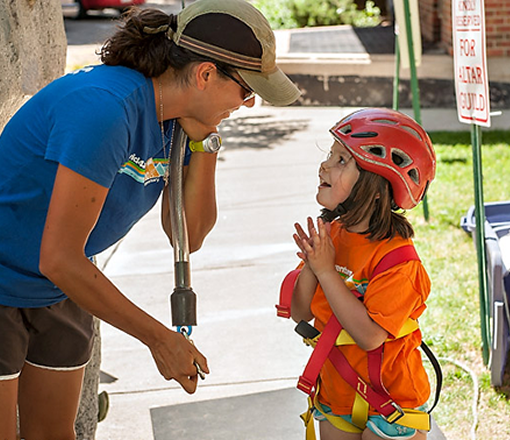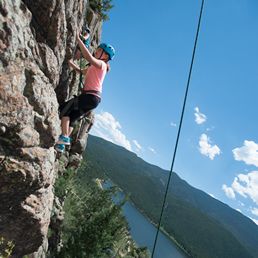6 things to do to support positive risk taking in kids
June 3, 2015 | Amy Diiullo

Not all risks are bad: Why we shouldn’t bubble wrap our kids
There was a time when my son, Jack, banned me from the skateboard park. Yes, banned. It could be because I constantly gasped and hollered, “Are you OK, sweetie” when he fell, which was a lot. To be fair, I was an equal-opportunity worrier and also yelled that same question (minus the “sweetie”) to every kid that crashed – despite their age. I couldn’t help it. Despite knowing we did everything to lessen the possibility of Jack getting hurt — well, everything except investing in a bubble wrap company — it happened. BUT, I’m the first to say that despite a chipped tooth, some stitches, and bumps and bruises along the way, weighing the risks of the potential pay-off of Jack stepping out of his comfort zone and challenging himself far outweighed the severity of any accident (and I’m knocking on wood it continues).  Let’s face it, no one wants to see a child fail or get hurt. It doesn’t matter if kids are playing on a team, learning to ride a bike, or trying out for a play. At some point though, we have to lower the safety net for kids to explore new things, discover passions and go beyond expectations so they can grow and thrive. Everything has some element of risk, so how can we support our kids and help them take good risks? We’ve got some great suggestions to help.
Let’s face it, no one wants to see a child fail or get hurt. It doesn’t matter if kids are playing on a team, learning to ride a bike, or trying out for a play. At some point though, we have to lower the safety net for kids to explore new things, discover passions and go beyond expectations so they can grow and thrive. Everything has some element of risk, so how can we support our kids and help them take good risks? We’ve got some great suggestions to help.
- Know your child. Is your kiddo a natural risk taker or is he risk averse? If your child is more adventurous, you may have to rein him in and talk about positive, safe risks and responsible decision-making. If your child is more hesitant to try new things, he may need a bit more encouragement. No matter your child’s personality, listen to their concerns or fears and let him know it’s OK. You want your child to know you understand and support him.
- Know yourself. Don’t pass your anxieties down to your child. They have enough of their own issues without adding yours to the mix. You may have a fear of water, but try your darndest not to wince, cringe and make noises when your child wants to learn how to kayak. It’s funny (and not in the ha ha way) how a child’s willingness to give something a try depends on your reaction.
- Don’t force anything . . . ever. You may know your child will ultimately love rock climbing as much as you do, but never force them to try until they’re ready. If you do, chances are it’ll backfire, and they may never want to try it. Instead, be patient, and let your child watch if she’s hesitant. Once she sees the safety harness and other measures in place, her fears may subside. And, by the way, when a child is already anxious, trying to reason with them is wildly ineffective. A better bet is to be reassuring.
- Do an “environmental debrief” with your child. At Avid4 Adventure, before any activity begins, counselors and campers talk about what’s changing in the environment. If you’re going biking, could the trail go from paved to dirt? If you’re hiking, could you come across a hazard like poison ivy? No matter the activity, do you notice if dark clouds are forming? Environmental debriefs let kids identify potential risks on their own as they paint a picture of what’s changing around them.
- Help your child be in control. It’s scary when things are unpredictable and unknown. When your child is trying something new, make sure they know what to expect. If they’re mountain biking, will the trails have hills, bumps or obstacles? Also, take the time to explain the safety measures to take to avoid (or lessen) the chance of a serious accident – helmet and pads.
- Teach responsible decision-making. Avid4 Adventure Camp Director, Ryne Willis, explains three steps Avid4 Adventure teaches kids to think about when approaching a risk. The first step to approaching a risk is identifying what’s changed in the environment. Let kids tell you that a trail gets steep or the terrain changes to loose rock. Once the risks are identified, ask your child what can happen when you encounter the risk. Let them tell you they can fall or hurt a knee. The third point is asking what your child can do to mitigate the risk. Let your child use their critical thinking skills. Maybe he’ll tell you to go slow or to space yourselves out in a single line. Whatever your child says – even if the idea is far-fetched – explore it with them to see how the situation could play out. Remember that these responsible decision-making tools don’t just pertain to outdoor adventures. These steps can be used in day-to-day experiences, and as kids grow and risks and consequences get higher, you’ll be glad your child knows how to safely assess situations.
There’s risk in embracing even the smallest risk. Think about the value of a skinned knee. Over the years, there’s been a shift in making sure kids are safe all the time. All. The. Time. If a consequence isn’t life threatening, let your child experience it. When your child skins their knee (and, of course, they will many, many times), they’ll learn to create judgments and tie back to the decisions that led to the skinned knee. That type of critical thinking can only be done through experiences.
Kids grow by learning how to assess situations, use sound judgment, and make good decisions as they take appropriate risks. So, what are some benefits of supporting our little risk takers?
- Increased confidence. As kids try new things, they build skills and learn tools to be successful. As their confidence increases, kids are more inclined to reach beyond their comfort zones and grow.
- Improved reasoning and coping skills. It’s through challenges that we learn to preserve. Whether kids succeed or fail, they learn something from each experience. Kids also find out there’s not just one way to solve a problem or finish a challenge. The goal is to give them the tools to manage experiences.
- Increased strength. Yes, yes, kids will become physically stronger as they embrace new activities, and it’s fun for them to see how their bodies react to physical challenges. But, we all know strength isn’t only physical. Kids will develop the knowledge needed as a result of taking a risk and how to apply it in the next situation.
 I know it can be hard to let our kiddos try new things. Truly, I do. But I also know that we would be doing our kids a disservice by not letting them gain new experiences that build strength, confidence and skills that they’ll use their entire lives. Risk taking isn’t inherently bad or dangerous, and it’s time to erase any negative connotations around it. Teaching kids to make safe, responsible decisions is the direction to go!
I know it can be hard to let our kiddos try new things. Truly, I do. But I also know that we would be doing our kids a disservice by not letting them gain new experiences that build strength, confidence and skills that they’ll use their entire lives. Risk taking isn’t inherently bad or dangerous, and it’s time to erase any negative connotations around it. Teaching kids to make safe, responsible decisions is the direction to go!
Visit Avid4 Adventure to learn more about their summer camps. Also check out more information on Ryne Willis, Director of our NEW Denver Camp location in Stapleton or any of our amazing Camp Staff
About the Author: Lynne Marsala Basche spent most of her career on the island of Manhattan at two New York publishing companies. A multi-year Avid4 Adventure mom and a new contributor to the Avid4 Adventure website, Lynne’s writing adventures also take her to championing volunteerism and regional recreation stories as a staff writer for the Castle Pines Connection newspaper, as well as supporting separate large corporate communications programs. By trying to keep pace with her mountain biking, rock climbing, snowboarding, lacrosse playing, unicycling, tae kwon do-loving 11-year old son, she, like most Avid4 parents, loves sharing the value of outdoor recreation and its positive influence on children’s health and confidence development. Lynne lives in Castle Pines, Colorado and regularly immerses herself in outdoor activities with her family where she also runs her freelance writing company, Blue Spruce Creative
Tagged: benefits of outdoor acitivites, getting kids outside, kids outdoor activities, summer camp






